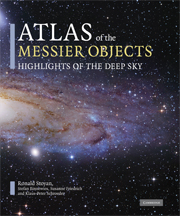Book contents
- Frontmatter
- Dedication
- Contents
- Foreword
- Preface
- User Guide
- Charles Messier
- The Observations
- The Catalog
- Statistics of the Messier objects
- Visual observation of the Messier objects
- Photography of the Messier objects
- The 110 Messier objects
- Glossary of technical terms
- Index of figures
- Index of sources
Preface
Published online by Cambridge University Press: 05 August 2015
- Frontmatter
- Dedication
- Contents
- Foreword
- Preface
- User Guide
- Charles Messier
- The Observations
- The Catalog
- Statistics of the Messier objects
- Visual observation of the Messier objects
- Photography of the Messier objects
- The 110 Messier objects
- Glossary of technical terms
- Index of figures
- Index of sources
Summary
The catalog gathered by the French astronomer Charles Messier (1730–1817) has been the most popular compilation of astronomical objects beyond our Solar System for more than 200 years. It contains 110 star clusters, nebulae, and galaxies, among them most of the brightest and finest deep sky highlights that are visible from northern skies.
Amateur and professional astronomers alike have turned their telescopes time and again to the Messier objects. Numerous books have covered them, and numerous websites attest to their unwavering popularity. However, a current overall picture of the catalog and its objects was missing, as much information currently disseminated is actually outdated. So, for the first time since Robert Burnham's famous Celestial Handbook, a thoroughly investigated new account with historical, astrophysical, and observational information on all the objects had to be conducted.
Many discrete tasks were associated with this book. Historical information on Charles Messier, his observations and his catalog had to be compared to latest level of knowledge. In addition to our own research, the biography published by Jean-Paul Philbert in the French language proved especially helpful. The main task was the compilation of recent astrophysical information on all of the objects. More than 500 scientific papers were compiled and evaluated. These texts are complemented by extensive observational notes, which incorporate the visual use of large modern reflectors.
A major part of the book is the more than 150 fantastic photos by leading amateur astrophotographers from all over the world. Occasionally, these images are accompanied by photographs from the Hubble Space Telescope, where this adds value. In addition, an extensive collection of visual drawings is shown, both from the classical era of the nineteenth century, as well as modern sketches drawn by the author himself.
The compilation of this book took much effort over the past five years. Many of the images were prepared exclusively from such exotic spots as Greece, Chile, and Namibia.
- Type
- Chapter
- Information
- Atlas of the Messier ObjectsHighlights of the Deep Sky, pp. 9Publisher: Cambridge University PressPrint publication year: 2008



